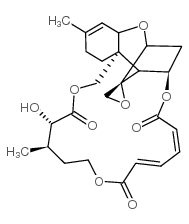CHEMICAL IDENTIFICATION
-
RTECS NUMBER :
-
WH1314900
-
CHEMICAL NAME :
-
Spiro(16,18-methano-1H,3H,23H-(1,6,12)trioxacycloocta decino(3,4-d)(1)benzo pyran-17(18H),2'- oxirane)-3,9,14-trione, 4,5,6,7,16,16a,19a,22-octahydro-4-hydroxy-5,16a,21-tr imethyl-, stereoisomer
-
CAS REGISTRY NUMBER :
-
3148-09-2
-
LAST UPDATED :
-
199209
-
DATA ITEMS CITED :
-
9
-
MOLECULAR FORMULA :
-
C27-H34-O9
-
MOLECULAR WEIGHT :
-
502.61
HEALTH HAZARD DATA
ACUTE TOXICITY DATA
-
TYPE OF TEST :
-
Standard Draize test
-
ROUTE OF EXPOSURE :
-
Administration onto the skin
-
SPECIES OBSERVED :
-
Rodent - guinea pig
-
TYPE OF TEST :
-
LD50 - Lethal dose, 50 percent kill
-
ROUTE OF EXPOSURE :
-
Intravenous
-
SPECIES OBSERVED :
-
Rodent - rat
-
DOSE/DURATION :
-
870 ug/kg
-
TOXIC EFFECTS :
-
Details of toxic effects not reported other than lethal dose value
-
TYPE OF TEST :
-
LD50 - Lethal dose, 50 percent kill
-
ROUTE OF EXPOSURE :
-
Intraperitoneal
-
SPECIES OBSERVED :
-
Rodent - mouse
-
DOSE/DURATION :
-
500 ug/kg
-
TOXIC EFFECTS :
-
Skin and Appendages - dermatitis, other (after systemic exposure) Biochemical - Metabolism (Intermediary) - effect on inflammation or mediation of inflammation
-
TYPE OF TEST :
-
LD50 - Lethal dose, 50 percent kill
-
ROUTE OF EXPOSURE :
-
Subcutaneous
-
SPECIES OBSERVED :
-
Rodent - mouse
-
DOSE/DURATION :
-
3900 ug/kg
-
TOXIC EFFECTS :
-
Details of toxic effects not reported other than lethal dose value
-
TYPE OF TEST :
-
LD50 - Lethal dose, 50 percent kill
-
ROUTE OF EXPOSURE :
-
Intravenous
-
SPECIES OBSERVED :
-
Rodent - mouse
-
DOSE/DURATION :
-
1500 ug/kg
-
TOXIC EFFECTS :
-
Details of toxic effects not reported other than lethal dose value
-
TYPE OF TEST :
-
LD50 - Lethal dose, 50 percent kill
-
ROUTE OF EXPOSURE :
-
Intravenous
-
SPECIES OBSERVED :
-
Rodent - rabbit
-
DOSE/DURATION :
-
540 ug/kg
-
TOXIC EFFECTS :
-
Details of toxic effects not reported other than lethal dose value
-
TYPE OF TEST :
-
TDLo - Lowest published toxic dose
-
ROUTE OF EXPOSURE :
-
Intravenous
-
SPECIES OBSERVED :
-
Rodent - rat
-
DOSE/DURATION :
-
14 mg/kg/8W-C
-
TOXIC EFFECTS :
-
Blood - changes in leukocyte (WBC) count
-
TYPE OF TEST :
-
TDLo - Lowest published toxic dose
-
ROUTE OF EXPOSURE :
-
Intravenous
-
SPECIES OBSERVED :
-
Primate - monkey
-
DOSE/DURATION :
-
5 mg/kg/50D-C
-
TOXIC EFFECTS :
-
Blood - leukopenia Blood - changes in cell count (unspecified) Related to Chronic Data - death
MUTATION DATA
-
TYPE OF TEST :
-
DNA inhibition
-
TEST SYSTEM :
-
Rodent - mouse Lymphocyte
-
DOSE/DURATION :
-
1 nmol/L
-
REFERENCE :
-
PLMEAA Planta Medica. (Georg Thieme Verlag, Postfach 732, D-7000 Stuttgart 1, Fed. Rep. Ger.) V.1- 1953- Volume(issue)/page/year: 34,231,1978
|

